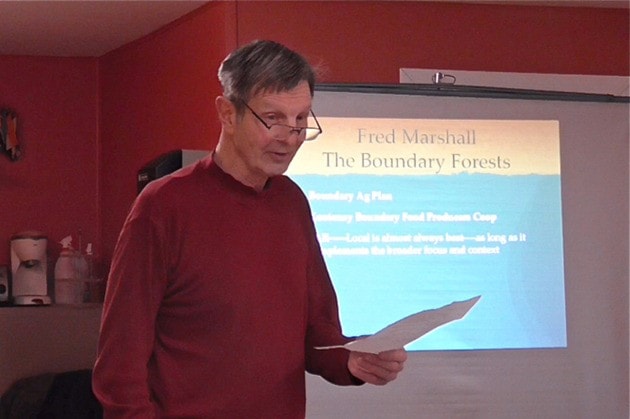Part two of a two-part series
The West Boundary Food and Resources Society welcomed local forest expert Fred Marshall to its Jan. 30 meeting at the Rock Creek Health Centre to provide members with an overview of the Boundary timber supply area and its importance as not only an economic driver, but also a vital player in the area’s ecosystem.
“I am a forester, so lumber is good,” Marshall said, “but it’s important to recognize that our forests are not only a source of timber but are also home to many creatures, significant recreational areas and many other things.”
Marshall identified the Boundary’s primary economic drivers as forestry, tourism, agriculture (including cattle and ornamental nurseries such as Hansinger’s and Stewart Brothers), mining and government services. He noted the fact that, while there are nurseries that employ hundreds of people to produce plants and flowers, not nearly the same attention is paid to food production, which, Marshall suggested, may change if the price of food continues to climb.
Marshall went on to outline the distribution of timber harvesting rights, noting that Weyerhauser and Interfor own the rights to 56 per cent of the allowable annual cut (ACC) in the Boundary.
He also described how the West Boundary (Midway/Greenwwod) community forest works, by the hiring of independent contractors to plan the layout of the logging area and harvest the timber, which is subsequently sold to mills such as Vaagen Fibre, as well as highlighting the existence of 34 private woodlot licences. These allow areas of private or leased land up to 1,200 hectares to be logged.
Marshall himself is the holder of one such licence. He listed the area’s major sawmills and buyers of fibre as Interfor, Vaagen Fibre, Son Ranch, John Lindquist, Ed Carson and one at Christina Lake There are also other smaller operators scattered throughout the region, in addition to several buyers from outside the Boundary, including Gorman’s, Kalesnikoff and Zelloff, illustrating not only the size of the forestry industry in the area, but also the fact that many operators are family owned, which bodes well for the health of the industry.
That said, Marshall did lament the fact that the provincial government clearly supports the continued expansion of the larger players such as Interfor, making it more difficult for the smaller operations, including trucking companies, to remain competitive.
“I’d like to see 50 per cent of the lumber harvested in the Boundary stay in the Boundary,” Marshall said. “The forests here belong to us and it is we who should be reaping the benefits of this valuable resource.”
Several members of the audience offered their own observations about environmentalism in general, including Terry Jackson, who described his recent eye-opening experience driving through Texas on his way home from Mexico. “Parts of the state looked like an industrial wasteland and the same applied to Southern Nevada, “Jackson said.
The audience in general felt that British Columbia could be doing a better job with the environment.
Marshall concluded by suggesting the forest needs more constructive management and that the province and its legislation should be viewing the industry with communities in mind as opposed to large corporations.
